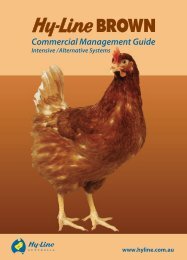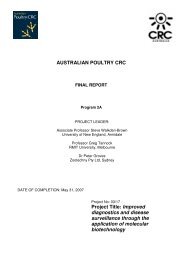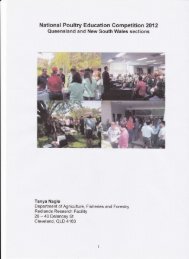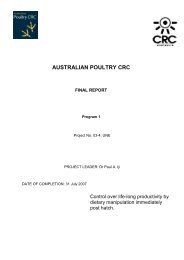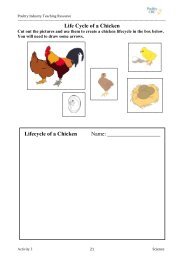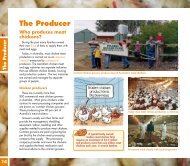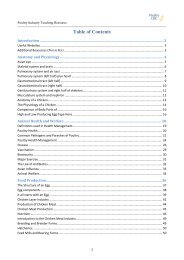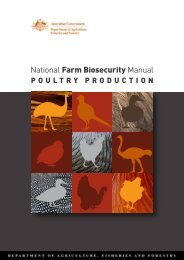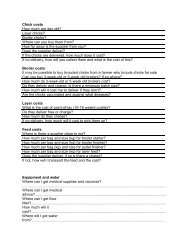AUSTRALIAN POULTRY CRC - Poultry Hub
AUSTRALIAN POULTRY CRC - Poultry Hub
AUSTRALIAN POULTRY CRC - Poultry Hub
- No tags were found...
You also want an ePaper? Increase the reach of your titles
YUMPU automatically turns print PDFs into web optimized ePapers that Google loves.
Feather pecking is considered a welfare problem because it potentially leads to cannibalism especiallywhen exposed skin is injured (Allen and Perry, 1975 and Appleby and Hughes, 1991). Cannibalismhas been defined in many ways, the most objective describing it as the “pecking and tearing of the skinand underlying tissues of another bird” (Keeling, 1994). Cannibalism is more common in non-cagesystems than cage systems. The most common form is vent pecking. Vent pecking is characterised bydamage to the cloaca, the surrounding skin and underlying tissue by a conspecific and can progress toevisceration and death (Pötzsch et al., 2001). It generally occurs soon after the birds have come intolay and may be linked to hormonal changes at the time. Cannibalism causes severe welfare andeconomic problems in modern egg production.DiseaseThe risk of disease spread by contact between birds, or by contact between birds and faeces, isgenerally regarded as more severe in non-cage systems (Appleby and Hughes, 1991). Contact betweenbirds can include flock mates and wild birds. Free-range poultry and their eggs are more likely to beinfected by virus and parasites than caged birds and their eggs (Glatz and Ru, 2004). These poultry aresusceptible to the same metabolic diseases affecting intensively housed birds, but the environment caninfluence their severity and make the birds susceptible to syndromes rarely found in caged layers(Mostert et al., 1995). A comparison of European cage and free-range systems found that free-rangehens had more endoparasites and zoonoses (salmonella) (Bestman, 2005). It was found that ifmortality exceeded 20% this was often caused by cannibalism however some other causes of mortalityincluded coccidiosis, fatty liver, Infectious Bronchitis, Coli, Amyloidosis and Brachyspira (Bestman,2005). Following are some brief notes of common diseases and parasites found in poultry.Infectious coryzaInfectious coryza is an acute respiratory disease of chickens (Blackall, 1999). The main signs of thedisease are inflammation of eyes and nose with foul-smelling discharges, conjunctivitis, sneezing andfacial swelling. Bacterium causing this disease is Haemophilus paragallinarum. Feed and waterintake is reduced, leading to loss of weight and egg production in laying birds will drop. Mortalitywill vary with the virulence of the infection but is generally low. Chickens of all ages are susceptible,with an incubation period of 1-3 days and disease duration of 2-3 weeks (The Merck VeterinaryManual, 2005).Newcastle diseaseNewcastle disease is a highly contagious disease that affects the digestive, respiratory and/or nervoussystems of poultry and is caused by a virus of the family Paramyxoviridae (Kahn, 2005 and Saif,2003). Newcastle disease causes high mortality with depression and death in 3 to 5 days as majorsigns. Labored breathing with wheezing and gurgling, accompanied by nervous signs, such asparalysis or twisted necks are the main signs. Egg production will drop 30 to 50% before returning tonormal levels in about 2 weeks. The disease easily spreads by contact with infected or diseased birds,it is excreted in manure, is expired in the air and can be spread through contaminated equipment,carcasses, water, food and clothing. The virus survives for long periods at ambient temperature, andcan persist for 12 months in sheds (faeces and dust) (McMullin, 2004).Infectious bronchitisInfectious bronchitis is an acute, rapidly spreading, viral disease of chickens spread by airbornedroplets, ingestion of contaminated feed and water and contact with contaminated clothing andequipment (Kahn, 2005). In young chicks IB virus infection causes a cheesy exudate in the bifurcationof the bronchi, thereby causing asphyxia, preceded by severe respiratory distress. In chicks under 3weeks of age mortality may be as high as 30 or 40 percent. In older birds IB does not cause mortalityhowever egg production will decrease dramatically and deformed eggs with wrinkled shells will oftenbe laid.2



